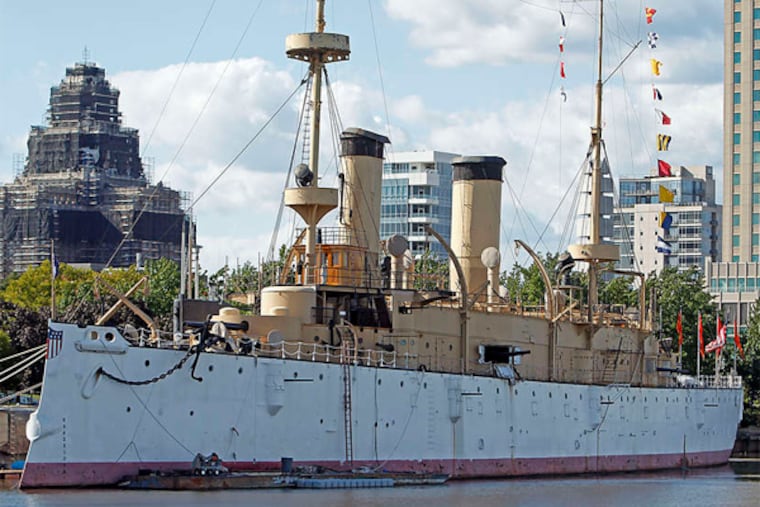A plan to save the USS Olympia

The plight of the USS Olympia has been an issue for more than a decade, and today this icon of American history is in danger of sinking because of long-deferred maintenance.
The ship became famous as the flagship of Commodore George Dewey at the Battle of Manila Bay during the Spanish-American War in 1898. The ship saw service in World War I patrolling the American coast and escorting transport ships. In 1921, she carried the remains of World War I's Unknown Soldier from France to Washington, where the body was interred at Arlington National Cemetery. Olympia was decommissioned in December 1922 and placed in the Navy Reserve fleet.
In 1957, in response to a request from the Cruiser Olympia Association to bring the ship to Philadelphia to serve as a museum, the Navy turned over the ship to the association, and the ship was restored and became a floating museum.
Olympia is today the oldest steel U.S. warship still afloat. But the ship's current steward, the Independence Seaport Museum, has been unable financially to keep the ship in good condition and has been directed by the Navy to put the ship up for availability to new stewards.
In the last three years there have been various attempts to find a way to save the ship, but a good solution has yet to materialize. There are now two remaining groups in the running for the opportunity to take over - an organization in California and a second in South Carolina. The City of Philadelphia and other interested groups from the area have so far failed to develop a viable plan to save the ship and keep it here. But time is running out. If adequate funding and a viable plan do not emerge soon, the ship will have to be scrapped.
There is one last-gasp effort underway by Philadelphia-area people to save the Olympia for future generations. They have developed a promising plan for the restoration and re-berthing of Olympia that would allow the ship to remain here.
The solution is to permanently dry-dock Olympia in Dry Dock No. 1 at the Philadelphia Navy Yard.
This approach would save millions of dollars in structural repairs, which would not be required since the ship would not be afloat. Furthermore, the funding required for periodic dry-docking (recommended every 15 to 20 years for museum ships) would be unnecessary. Permanent dry-docking also would ensure no further deterioration of the now razor-thin "wind and water" area of the hull plating.
Dry Dock No. 1 at the Navy Yard sits idle and is too small to be viable commercially. It is the perfect size for Olympia. The dry dock is itself a historic structure. It is a graving dock designed by and constructed under the supervision of Adm. Robert E. Peary, a famous explorer of the North Pole. It was commissioned in 1891, a year before the launching of Olympia.
The Olympia would be displayed in the dry dock at street level, with a shallow pool of water surrounding her to make her appear to be afloat. In addition to touring the decks and interior of the ship, visitors would be able to go down into the dry dock to see the underwater portion of the hull, as well as the interior of the dry dock itself. At night the ship would be bathed in light, a spectacular sight for airline passengers as they land at Philadelphia International Airport.
Dry Dock No. 1 is owned by the Philadelphia Industrial Development Corp., a nonprofit, joint venture of the city and the Greater Philadelphia Chamber of Commerce. The dry dock is surrounded by a dynamic, growing corporate business campus of more than 130 companies and 10,000 employees.
This plan seems to have great promise, but it will require that Philadelphia's business and government leaders step up and work together. The city has been entrusted with a national treasure, and to allow this historic ship to leave Philadelphia's waterfront, either on its way to the scrap pile or to another city, would be a sad day, one that would implant a stain on the people of the region.
In 1958, the Navy was planning on scrapping the USS North Carolina, a ship with a distinguished record during World War II. The governor and the citizens of North Carolina stepped forward and initiated a "Save Our Ship" campaign.
The campaign raised what would be more than $2.4 million in today's dollars, and more than 700,000 schoolchildren saved their spare change and lunch money for it. That famous ship was saved because leaders stood up and demonstrated real leadership. They saved a great ship that today is afloat in Wilmington, N.C., generating millions of tourism dollars for the state each year.
Time is running out for the USS Olympia. Philadelphia has a long and great naval and maritime history, and Philadelphians should not let this ship go anywhere. It can and should remain as a museum, teaching new generations of Americans about their country's great naval history.
Restoring the USS Olympia and permanently displaying it in the historic Dry Dock No. 1 is the right and honorable thing to do.
John F. Lehman served as secretary of the Navy for President Ronald Reagan, and Christopher M. Lehman served as special assistant for national security affairs for President Reagan